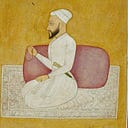Above is a chart I constructed using Mansabdari data, tabulated by Dr. Shakil Akhtar from Aligarh University. For those unaware, Mansabdari refers to the administrative system introduced by the Mughals of India, whereby officials in either the military or civic realm could be granted levels of nobility based on their service to the empire.
The Mansabdari system was a delicate balancing act for a ruler. Loyal factions needed to be rewarded, while potential rivals needed to be pacified. The fluctuations seen across ethnic groups reflect how easy it was to fall in (or out) of favor as each new king came to power. Groups could be elevated after supporting the right candidate during a succession crisis, or as a means of checking another faction that was seen as too influential.
The most interesting trend observed from the data relates to the Hindus. They exhibited consistent growth throughout the Mughal period, and by the late 17th century, comprised a plurality of all nobles (36%). Virtually all Hindu nobles were either Rajputs or Marathas; the Rajputs comprised the early majority during the Mughal conquests in the north, before being edged out by the Marathas as the Mughal campaigns shifted south.
When looking at the Indian Muslim and Hindu groups together, one can note how they went from furnishing 0 nobles during the early Mughal period, to making up a slight majority (50.7%) of all nobles by the late 17th century. The Afghans and Iranians seemed to enjoy relatively stable representation, while the Turks experienced a consistent downward trend.
We should also be aware of how vague the distinction between “foreign” Muslims and Indian Muslims could be. Many of the designated Turks, Iranians, and Afghans were only partially descended from these groups; their ancestors for generations having lived in India and intermarried with Brahmin and Rajput women. Conversely, a number of designated Indian Muslims had the same mixed ancestry as the above group, but for a number of reasons did not claim to be outright Iranians, Turks, or Afghans.
That is all. Source for figures with further reading below!
